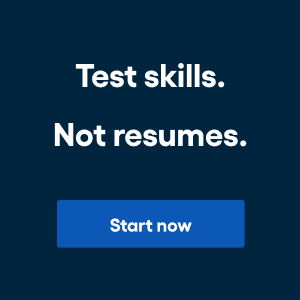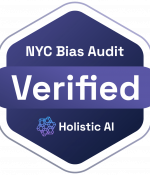Many business leaders have committed to increasing diversity and inclusion in 2021. Yet, few companies are prepared to do so: lacking either the resources or the information to hire and retain diverse candidates effectively.
The path toward a more diverse workforce starts with understanding how to measure diversity, equity, and inclusion. For some organizations, this means assessing their current hiring practices to root out unconscious biases. For others, this means including new targets for advancing diverse employees to higher positions of leadership.
Diversity and inclusion are fluid targets that require ongoing evaluation and reassessment. These targets start by understanding the best quantitative diversity metrics and how to measure inclusion.
What is the goal of diversity and inclusion?
The goal of diversity and inclusion initiatives is to create a workplace that accepts, supports, and values employees from all different backgrounds. Not just different ethnicities, genders, ages, religions, disabilities, and sexual orientations, but also skill sets, experiences, and differences in education.
Diversity and inclusion policies aren’t just good for your employees’ wellbeing; it’s good for business, too. Overall, diverse and inclusive companies perform better than their homogeneous counterparts in everything from innovation and profit to employee retention, talent recruitment, and other areas of business that contribute to value creation and long-term growth.
[Read more: The Ultimate Guide To Diversity Hiring]
“An inclusive workplace and business strategy can catalyze innovation and uncork a reservoir of rich, nuanced ideas, while bringing multidimensional perspectives to an enterprise that can only come from diverse employee experiences,” executives from 3M, Fidelity, and KPMG told the US Chamber of Commerce.
Bottom line: a meaningful commitment to diversity and inclusion is good for your employees — and your shareholders.
How to measure diversity
Improving diversity means creating a workforce of employees from different backgrounds. Diversity, therefore, relates specifically to hiring. Diversity metrics are usually related to overcoming unconscious biases in the hiring process.
[Read more: Hiring Bias Is Hurting Your Recruitment Process]
Here are some diversity recruiting metrics that can help your team to begin tracking diversity and assess whether there are unconscious biases preventing your organization from fulfilling its diversity and inclusion goals.
- Candidate demographics: The percentage of employees from specific identity groups (e.g., LGBTQIA) to the labor market or industry benchmarks.
- Candidate outreach: Are your employer branding efforts reaching candidates from diverse groups? Keep track of the ways in which your recruiters are making contact with organizations designed to help underrepresented groups get hired. For instance, attend conferences and job fairs for veterans. Then, track the number of applications received, and how many applicants progress through your hiring process to see if your outreach efforts are working.
- Candidate advancement: How many applicants from target groups apply to your open positions compared to the size of the group in the overall labor market? How many applicants from target groups successfully make it to each stage of the hiring process compared to all candidates?
- Candidate selection: How many individuals from target groups are hired as compared to members from dominant groups?
These diversity metrics examples are just the starting point for understanding how diverse candidates experience your hiring process. An applicant tracking system can provide insight into these key metrics.
Once you have an overview of where there may be barriers preventing diverse candidates from joining your team, you can dive deeper to see if there are ways to adjust your job descriptions, pay scale, or benefit package to be more inclusive.
How to measure inclusion
If diversity measures who is at the table, inclusion is a measure of how supported or empowered the people at the table feel. Inclusion tells you about the culture that empowers your workforce to be successful.
Inclusivity is manifested in the policies and procedures that your company creates to make everyone in the workplace feel valued. It’s also a more challenging thing to measure, in part because the psychological safety your employees feel is so subjective. “The importance of inclusion is easy to understand, but the layers of company culture that make up ‘inclusion’ aren’t,” wrote SurveyMonkey. “Unlike diversity, inclusion is heavily rooted in employees’ individual experiences—which aren’t easy to monitor or quantify.”
If you’re wondering how to measure inclusion, start by asking your employees these two questions:
- Do you feel you have an equal opportunity to succeed here and reach your full potential?
- How have you observed and/or experienced bias, discrimination, and inequity?
Then, start to dig deeper. Look at key indicators such as:
- DE&I Statement: Does your company have a DE&I statement? Do your employees know what it is? Do they feel the statement is more than just a marketing exercise?
- Employee Resource Groups: Are mentorship programs and Employee Resource Groups (ERGs) available to diverse employees?
- Advancement: Track the number of promotions awarded to individuals in special identity groups compared with individuals from other groups — are promotion rates similar or proportional?
- Pay equity: Are you offering equal pay for equal work? Are you transparent about pay levels and payscale?
- Employee benefits: Are your benefits packages equitable and considerate of needs of employees from all different backgrounds?
- Employee retention: What is your diverse employees’ tenure compared to your employees from a dominant identity group?
By answering these questions, you can begin to build a culture that’s welcoming to employees of all backgrounds.
Tools to track your diversity effort
A diversity recruiting dashboard is one way to hold your organization accountable for these key metrics. This dashboard does not need to be complicated: Buffer, for instance, uses a simple landing page of charts showing progress in hiring target groups such as military veterans, employees with disabilities, non-native English speakers, and family status.
This diversity recruiting dashboard serves both as an easy way to keep track of hiring goals as well as to be transparent on issues such as gender diversity and ethnic diversity. Buffer’s dashboard also provides an option to view by role type — filter by leadership, technical, and non-technical roles.
Not only does this help hiring managers stay on top of diversity hiring progress, it also aids in employer branding and employee engagement. Existing team members and potential candidates alike can see clearly how much progress is made toward Buffer’s commitment to diversity hiring.
For more diversity recruiting dashboards, check out this intel report that includes examples from Google, Microsoft, AT&T, and more.
Can there be such a thing as too much diversity?
“Too much” diversity isn’t really an issue — organizations are more likely to be accused of diversity issues such as reverse discrimination or tokenism. To avoid reverse discrimination, hiring targets should be set to remedy a protected group’s past barriers to opportunity. For instance, prioritizing a minority group for advancement to the managerial level is a legal diversity goal.
Tokenism is a potential pitfall that results from increasing diversity without improving inclusivity. Tokenism is when individuals from underrepresented communities are hired or promoted, but not given the same influence or treated with the same respect as their majority counterparts. As Forbes describes, a minority may be “on the team” but not be “in the game.”
To capture the full benefit of diversity, organizations need to invest in creating an inclusive culture. “Increasing the numbers of traditionally underrepresented people in your workforce does not automatically produce benefits,” said Harvard Business Review. “Taking an ‘add diversity and stir’ approach, while business continues as usual, will not spur leaps in your firm’s effectiveness or financial performance.”
The perception that there can be “too much diversity” likely comes from a lack of inclusivity. Adding diverse perspectives can lead to tension and conflict — unless an organization is prepared with the right tools, inclusive environment, and mindset.
How to increase diversity
There are a number of ways to reconfigure your hiring practices and encourage diverse candidates to join your team.
- Expand your candidate pipeline: Look for candidates outside of your traditional platforms and events. List open positions on sites like Tech Ladies, POCIT, Revision Path, or Power to Fly.
- Improve your job descriptions: Use a tool like Textio to ensure your job descriptions and position listings are written in gender-neutral, inclusive, and clear language to attract qualified candidates.
- Use a skills test: Skill tests can help overcome unconscious bias inherent in the interview process, as well as lead to happier, long-term hires.
[Read more: Everything You Need To Know About Skill Testing]
- Make interviewing more inclusive: Provide the option to video interview to accommodate candidates with mobility restrictions. Have multiple employees — from different backgrounds — interview candidates to provide a range of perspectives.
- Update your employer branding: Highlight all that you do to create an inclusive culture, such as the ways your company supports community initiatives or development training you offer employees.
Despite these clear steps that can lead to better diversity, many organizations struggle to achieve diversity targets. There are many reasons why this is — but before investing in diversity hiring, make sure your company has the right infrastructure and leadership commitment to make these initiatives successful.
[Read more: 5 Reasons Why Hiring Diverse Candidates Is Still Hard In 2021]
How to set diversity hiring goals
Quantitative measures of diversity hiring start with a baseline. Try an assessment like Hubspot’s worksheet designed to help you keep track of hiring metrics to see where your diversity hiring could be improved.
The next step is to get buy-in from your leadership team. Too often, diversity is seen as an “HR problem.”
“When the mandate for hiring diverse candidates falls on diversity and inclusion officers, but isn’t considered a business priority from the CEO, it becomes very difficult for recruiters to bring in diverse candidates,” writes Fast Company.
Present your diversity hiring goals, as well as the findings of your baseline survey, to build a business case for setting the bar higher. With buy-in from your senior leaders, you can then proceed to systematically improve diversity, equity, and inclusion at your company.
Want to learn more about diversity hiring? Check out Vervoe’s diversity recruitment software to get started.




















